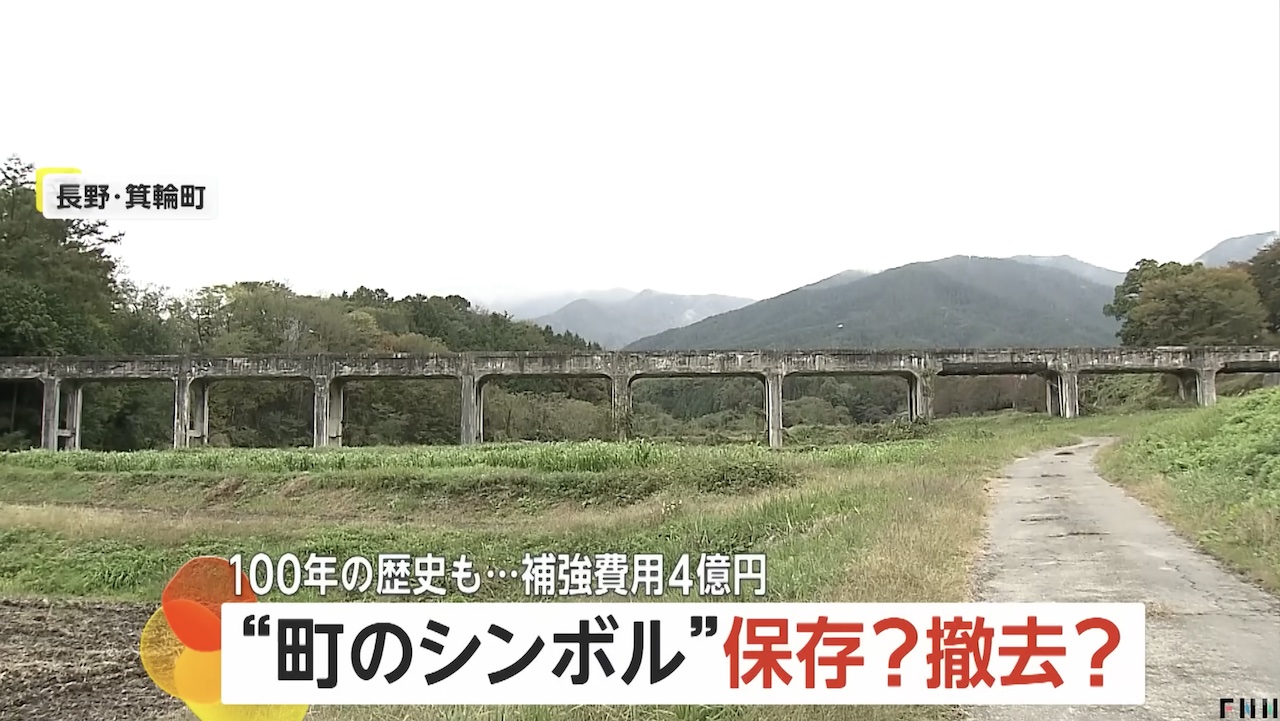Nagano, Oct 31 (News On Japan) - The question of whether to preserve or dismantle a nearly 100-year-old aqueduct bridge that stands as a town symbol is dividing opinions among the town and its residents.
The bridge at the center of this debate spans 145 meters in Minowa, a town in central Nagano Prefecture. Built in 1928, the bridge was selected as a modern civil engineering heritage site by the Japan Society of Civil Engineers.
For years, the bridge has served as a vital road for local residents. However, due to aging and structural wear, it was closed to all vehicles except pedestrians and bicycles from October.
Upon closer inspection, visible damage is apparent on various parts of the bridge, including peeling exterior walls and exposed structural frameworks on its underside. Some of the bridge’s pillars have deteriorated, with concrete crumbling and falling off.
In light of this deterioration, Mayor Masanori Shiratori stated in the September town council meeting that "the bridge has served its purpose."
Minowa Town Mayor Masanori Shiratori: "The structure itself is significantly degraded, and rebuilding the bridge would be financially unfeasible. From a cost-benefit perspective, its role as a roadway bridge has been fulfilled."
When asked about preserving the bridge, the mayor responded, "I can’t say it’s entirely out of the question, but I don't believe it holds sufficient value to justify preservation."
The estimated cost to reinforce the bridge is at least 400 million yen, and additional expenses would be required to meet seismic standards, according to the town. Given the existence of a bypass route, the town is leaning toward demolition, arguing that preservation is not worthwhile.
For long-time residents who have relied on the bridge, the decision is emotionally charged.
Nearby residents commented, "If it's gone, it'll be tough to get to the fields, but I understand the town’s position. The bridge is in bad shape, and restoration would cost a lot," while others added, "I want it preserved, but given its condition, it would require too much funding," and "It’s historical and full of memories; I’d like to see it stay."
Advocating for preservation, a local committee that has worked with the town emphasizes the bridge’s significance.
Suirokyo Committee Chairman Bunsei Seki and Mitsuhiko Nakajima said, "We see it as a symbol of the Yaotome area," noting that aqueduct bridges are rare. "We hope to maintain it as part of the local scenery and honor the memories of those who have seen it since childhood."
The aqueduct bridge has been cherished as a landmark for almost a century, and some residents feel it should be preserved as a unique aspect of the town’s landscape.
Despite their differences, Mayor Shiratori does not wish for conflict.
Minowa Town Mayor Masanori Shiratori: "I am not pursuing this project with an intent to impose or create opposition. It’s an unavoidable decision we need to make."
Local committee member Mitsuhiko Nakajima echoed this sentiment: "If it’s truly unsafe, then it should be removed. We are weighing preservation against safety."
As the town and residents continue to weigh history and sentiment against practicality, a final decision on the bridge’s future remains undecided.
Source: FNN















